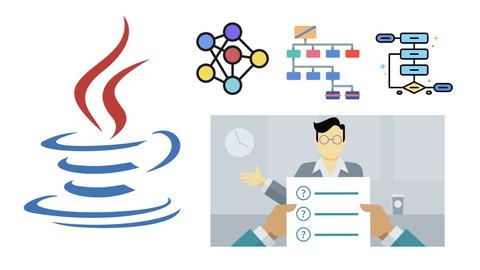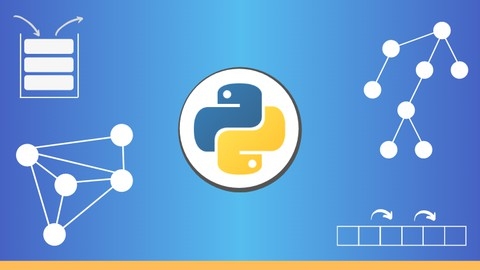Data structures and algorithms (DSA) are fundamental concepts in computer science, forming the backbone of efficient and effective software development.
Understanding DSA allows you to write programs that are not only functional but also performant, capable of handling large datasets and complex operations.
By mastering DSA, you’ll gain the ability to analyze problems, design optimal solutions, and build software that scales gracefully.
Finding the right data structures and algorithms course on Udemy can be challenging, as there are countless options available.
You’re likely looking for a course that’s comprehensive, engaging, and taught by experienced instructors, one that covers both theoretical concepts and practical applications, all while catering to your specific learning style and goals.
For the best data structures and algorithms course overall on Udemy, we highly recommend “The Complete Data Structures and Algorithms Course in Python”.
This course is renowned for its comprehensive coverage, engaging teaching style, and focus on practical application.
It starts with the basics, introducing you to concepts like Big O notation and arrays, and progresses to more complex data structures like linked lists, trees, and graphs.
You’ll learn how to analyze algorithm efficiency, solve coding problems, and prepare for technical interviews.
While this is our top pick, other great courses are available depending on your preferred programming language or learning style.
Keep reading to discover our full list of recommendations and find the perfect data structures and algorithms course to kickstart your coding journey.
The Complete Data Structures and Algorithms Course in Python
Starting with the basics, the course introduces you to the concepts of data structures and algorithms, explaining their importance in programming.
It covers a variety of data structures, including Arrays, Lists, and Tuples, and explores different algorithms, providing a solid foundation for your learning journey.
Python, known for its versatility, serves as the medium for instruction.
Even if you’re new to Python, the course includes a section to bring you up to speed, ensuring no learner is left behind.
A standout feature of this course is its detailed exploration of Big O Notation.
You’ll learn to measure algorithm efficiency, understand space complexity, and tackle input terms, equipping you with critical skills for optimizing code.
As the course progresses, you’ll encounter more complex data structures like Linked Lists (Singly, Doubly, and Circular), Stacks, Queues, Trees, and Graphs.
Practical coding exercises and projects complement the theoretical knowledge, allowing you to apply what you’ve learned in real-world scenarios.
For those aiming to ace tech interviews, the course includes sections dedicated to interview preparation.
You’ll practice with problems from companies like Amazon, Facebook, and Microsoft, preparing you for the challenges of a tech career.
The course also focuses on problem-solving strategies, guiding you through understanding and breaking down problems, and refining solutions.
This approach is crucial for tackling complex programming challenges effectively.
Advanced topics aren’t left out.
You’ll delve into Recursion, Dynamic Programming, Backtracking, and Graph Algorithms, including Dijkstra’s and Bellman Ford’s algorithms.
Topics like Minimum Spanning Trees, Greedy Algorithms, and Divide and Conquer Algorithms are also covered, providing a well-rounded understanding of DSA.
With quizzes, coding exercises, and a supportive student community, this course offers a rich learning experience.
It prepares you not just for interviews but for a successful career in programming.
Python Data Structures & Algorithms + LEETCODE Exercises
This course begins with the basics, such as setting up your code editor, and progresses to advanced topics, ensuring a complete understanding of essential concepts and their application in Python.
The journey starts with an “Overview” to guide you on how to benefit fully from the course.
You’ll quickly move on to Big O notation, learning to evaluate algorithm efficiency through lectures and quizzes on O(n), O(n^2), O(log n), and more.
This foundational knowledge is crucial for writing efficient code.
As you advance, the course covers key data structures, including classes, pointers, linked lists (LL), doubly linked lists (DLL), stacks, queues, trees, hash tables, graphs, and heaps.
Each section offers detailed explanations and Python implementations, complemented by coding exercises that reinforce your learning.
Sorting algorithms aren’t left out.
You’ll gain hands-on experience with bubble sort, selection sort, insertion sort, merge sort, and quick sort, understanding not just how to implement them but also their performance implications.
A standout feature of this course is its focus on interview and LEETCODE exercises.
After mastering each data structure or algorithm, you’ll tackle challenges that mirror real interview questions, from linked list manipulations to dynamic programming problems like memoization in the Fibonacci sequence.
The course also explores tree traversal (BFS and DFS), dynamic programming, and strategies for solving overlapping subproblems.
This approach ensures you’re equipped not just with coding skills but also with problem-solving strategies.
Wrapping up with a “Thank You!” note, the course emphasizes continuous practice.
You’re encouraged to revisit sections and exercises to solidify your understanding and skills.
Java Data Structures and Algorithms Masterclass
This course comprehensively covers everything from basic concepts to advanced topics, all through the lens of Java programming.
Let’s break down what this course offers and why it might be the right choice for you.
The journey begins with foundational knowledge, explaining the significance of data structures and algorithms.
You’ll quickly move on to understand Big O Notation, a critical tool for evaluating algorithm efficiency, covering various complexities like O(1), O(N), and O(N^2).
Arrays, both single and two-dimensional, are explored in depth.
You’ll learn to perform essential operations such as creation, insertion, access, and deletion.
Practical projects and coding exercises, including LeetCode challenges aimed at FAANG interview preparation, are integral parts of this section.
The course also dives into more sophisticated data structures like Linked Lists, Stacks, and Queues.
Through detailed examples, you’ll grasp the nuances of singly, doubly, and circular linked lists, and master stack and queue operations using arrays and linked lists.
Trees and binary trees receive thorough attention, with lessons on traversal, insertion, and deletion.
You’ll also study Binary Search Trees (BST), AVL Trees, and Binary Heaps, gaining insights into their operations and applications.
Graphs are another focus area, where you’ll learn about representation, BFS and DFS traversal algorithms, and tackle shortest path problems with Dijkstra’s and Bellman Ford algorithms.
Advanced topics like Minimum Spanning Trees, with Kruskal and Prim’s algorithms, are also covered.
For algorithmic strategies, the course offers sections on Recursion, Dynamic Programming, Divide and Conquer, and Greedy Algorithms.
You’ll solve complex problems using these techniques, sharpening your problem-solving skills.
Sorting and Searching Algorithms are comprehensively covered, including Bubble, Selection, Insertion, Merge, Quick, and Heap Sort, as well as Linear and Binary Search.
You’ll learn their implementations, efficiencies, and practical uses.
The course also teaches a structured approach to problem-solving and includes a section on Backtracking, where you tackle the N-Queens puzzle, among others.
With quizzes, coding exercises, and detailed solutions throughout, you’ll have ample practice opportunities.
Downloadable resources are available for further study.
Java Data Structures & Algorithms + LEETCODE Exercises
This course covers everything from the basics to advanced topics, making it ideal for beginners and those looking to refresh their skills.
The journey begins with an introduction to Java and strategies to maximize your learning.
Quickly moving forward, you’ll grasp Big O notation, learning to evaluate algorithm efficiency, understand worst-case scenarios, and recognize when to simplify your calculations.
This foundational knowledge is crucial for coding interviews and effective problem-solving.
The course extensively covers various data structures, including classes and pointers, linked lists (LL), doubly linked lists (DLL), stacks, queues, trees, hash tables, graphs, and heaps.
Each section offers detailed lectures on implementation in Java, operational insights, and performance analysis.
Quizzes and coding exercises are integrated throughout to solidify your understanding and application skills.
For linked lists, the course walks you through construction, manipulation, and advanced interview-level questions, such as detecting loops or finding the middle node.
Similarly, with doubly linked lists, you’ll learn operations like appending, removing, and checking for palindromes.
Stacks and queues are not just about implementation; you’ll also tackle real-world problems, like using stacks for balanced parentheses checks or simulating queues with two stacks.
The course doesn’t shy away from complex topics like trees and graphs, offering in-depth lessons on binary search trees (BST), tree traversal techniques (BFS and DFS), and graph operations.
Sorting algorithms, including bubble, selection, insertion, merge, and quick sorts, are demystified, teaching you the mechanics and appropriate use cases of each.
Dynamic programming is introduced with strategies like memoization and bottom-up approaches to solve problems efficiently, tackling classic challenges like the Fibonacci sequence.
LEETCODE exercises specific to each topic, from linked lists and trees to dynamic programming and sorting algorithms, are a significant part of the course.
These challenges test your knowledge and prepare you for technical interviews with problems ranging from array manipulation to validating BSTs and optimizing solutions.
JavaScript Data Structures & Algorithms + LEETCODE Exercises
The journey begins with an introduction to the basics, including setting up your code editor, followed by a deep dive into Big O notation.
This section is crucial for understanding algorithm efficiency, covering everything from O(n) to O(log n), and teaching you how to evaluate your code’s performance effectively.
The course then moves on to Classes and Pointers, essential for grasping more complex data structures.
You’ll explore Linked Lists (LL) and Doubly Linked Lists (DLL), learning their inner workings and practicing with coding exercises.
These sections also include targeted interview and LEETCODE exercises, sharpening your problem-solving skills.
Stacks and Queues are next, where you’ll learn their implementation and analyze their performance.
The course ensures you get hands-on experience through coding exercises and interview questions, reinforcing your understanding.
In the Trees and Graphs sections, you’ll tackle Binary Search Trees (BST) and delve into graph theories.
These modules are packed with exercises that challenge you to apply what you’ve learned, from tree traversals to graph algorithms.
Sorting algorithms form a core part of the curriculum, with detailed lessons on Bubble Sort, Selection Sort, Insertion Sort, Merge Sort, and Quick Sort.
Each algorithm is accompanied by practical coding exercises and interview questions, preparing you for real-world applications.
Dynamic Programming is covered extensively, focusing on strategies like memoization and bottom-up approaches.
You’ll apply these to various problems, including the Fibonacci sequence, enhancing your problem-solving repertoire.
The course concludes with a series of coding exercises across a broad spectrum of topics, from arrays to dynamic programming.
These exercises test your knowledge and readiness for technical interviews.
Data Structures and Algorithms In C ( DSA )
The course starts with the basics, introducing you to the essential concepts and practices of data structures and algorithms.
A special lecture on setting up a source code repository gets you ready for practical coding exercises.
The course thoroughly covers algorithm performance analysis, including measuring running times, asymptotic analysis, Big O Notation, and time complexity analysis with practical examples.
This foundational knowledge is crucial for understanding how algorithms operate and their efficiency.
You’ll dive into various data structures, beginning with linked lists.
The course explores single, doubly, and circular linked lists, teaching you how to perform insertions, deletions, and traversals.
Quizzes after each section help solidify your understanding.
Stacks and queues are also covered in detail, with lectures on their implementation using arrays and linked lists.
Practical problems, such as validating nested parentheses and evaluating arithmetic expressions, demonstrate these concepts in action.
The course provides a comprehensive look at recursion, explaining its process and comparing it to iteration.
You’ll apply recursion to solve problems like calculating factorials, generating the Fibonacci series, and solving the Tower of Hanoi.
Tree structures, including binary trees, binary search trees, and heaps, are extensively covered.
You’ll learn about tree traversal, constructing trees from traversal results, and operations in binary search trees and heaps.
Each section includes examples and quizzes for reinforcement.
Sorting and searching algorithms are a major focus.
You’ll learn to implement and analyze selection, bubble, insertion, merge, quick, heap, and radix sorts.
The course also covers efficient data searching techniques, including linear and binary searches.
Hashing, a key technique for efficient data retrieval and storage, is explained in detail.
You’ll learn about hash functions, collision handling, and probing techniques, with a focus on separate chaining and open addressing methods.
As a bonus, the course offers recommendations and special offers on other courses to further your learning.
Data Structures and Algorithms In C# ( DSA )
The course kicks off with an introduction to data structures and algorithms, highlighting their importance in creating efficient software.
It emphasizes the need for a source code repository from the start, setting a solid foundation for your learning journey.
You’ll dive into critical concepts such as measuring algorithms’ running time, asymptotic analysis, and Big O Notation.
These sections are crucial for understanding how to optimize your code for better performance and efficiency.
Through practical examples, you’ll learn to identify Big O, and grasp tight and loose upper bounds.
Regular quizzes, like Introduction Quiz A and B, test your understanding of key concepts, ensuring you’re on track.
The course thoroughly covers various data structures, starting with linked lists.
You’ll master operations like insertion and deletion, and tackle more advanced topics like reversing linked lists and sorting them using algorithms like Bubble Sort and Merge Sort.
The curriculum also includes detailed lectures on doubly linked lists, circular linked lists, and linked lists with header nodes.
Next, the course explores stacks and queues, teaching you their array and linked list implementations.
You’ll learn their applications in expression evaluation and converting between infix and postfix notations.
Recursion is explained in a clear, understandable manner.
You’ll explore its applications, compare it with iteration, and work through algorithms like Euclid’s Algorithm and the Fibonacci series.
The course also delves into trees, including binary trees, binary search trees, and heaps.
You’ll learn to implement, traverse, and manipulate these structures in C#, gaining insights into tree sorting algorithms like binary tree sort and heap sort.
Sorting and searching algorithms are covered extensively.
From simple algorithms like selection sort and bubble sort to more complex ones like quick sort, merge sort, and radix sort, you’ll learn efficient techniques for organizing and locating data.
Hashing, crucial for quick data storage and retrieval, is explained in detail.
You’ll learn about collision handling, hash function design, and the implementation of open addressing and separate chaining.
The course concludes with a bonus lecture offering further learning opportunities and special offers on other courses.
Throughout, you’ll have access to source code examples in C#, quizzes to reinforce learning, and lectures that simplify complex concepts.
C++ Data Structures & Algorithms + LEETCODE Exercises
The course kicks off with an introduction that sets you up for success, followed by detailed instructions on configuring your coding environment.
Whether you use Windows, Linux, or Mac, you’ll receive step-by-step guidance for installing VS Code and the necessary compilers, allowing you to dive into coding without delay.
A deep dive into Big O notation early in the course equips you with the skills to assess your algorithms’ efficiency.
This foundational knowledge is crucial for writing high-performance code from the start.
The curriculum spans a wide array of topics, including pointers, classes, linked lists (LL), and doubly linked lists (DLL).
Each section is packed with coding exercises to solidify your understanding.
You’ll also explore stacks, queues, trees, and hash tables, gaining hands-on experience in managing data structures and implementing key algorithms.
Graphs, recursion, and sorting algorithms, from bubble sort to quick sort and merge sort, are thoroughly covered.
You’ll learn not just the theory but also the practical application of these algorithms, with exercises to test your skills.
Dynamic programming is another critical area this course covers, teaching you strategies like memoization and the bottom-up approach to solve problems efficiently.
Moreover, the course includes specialized sections for interview and LEETCODE exercises across various topics, ensuring you’re well-prepared for technical interviews.
Throughout the course, quizzes and coding exercises are strategically placed to reinforce learning and enhance problem-solving skills.
Whether tackling a palindrome checker, optimizing a Fibonacci sequence, or solving dynamic programming challenges, you’ll engage with real-world problems.
Data Structures and Algorithms In Java ( DSA )
The course kicks off with an introduction to Data Structures and Algorithms, laying a solid foundation for understanding their importance in efficient problem-solving.
You’ll also learn about setting up a Source Code Repository, preparing you for the coding challenges ahead.
You’ll then move on to understanding how to measure the running time of algorithms and grasp the concept of Big O Notation.
This section is crucial for evaluating algorithm efficiency and includes lectures on finding Big O, as well as understanding tight and loose upper bounds.
The journey continues with an in-depth look at various data structures, starting with Linked Lists.
From basic operations like traversing and searching to more complex ones like reversing and sorting, the course covers it all.
It also delves into doubly linked lists, circular linked lists, and linked lists with header nodes.
Next, you’ll explore Stacks and Queues, learning their implementations using arrays and linked lists.
This section also covers specialized forms like circular queues and priority queues, and applications such as validating expressions and evaluating arithmetic expressions.
Recursion is demystified through practical examples, teaching you when and how to use recursion effectively, with examples like calculating factorials and solving the Tower of Hanoi.
The course then guides you through Trees, starting with Binary Trees and progressing to Binary Search Trees and Heaps.
You’ll learn about their types, implementations in Java, and operations like traversal, insertion, and deletion.
Sorting and Searching algorithms are covered extensively, from basic sorts like Bubble Sort and Selection Sort to advanced ones like Merge Sort, Quick Sort, and Radix Sort.
You’ll learn their Java implementations and understand their time complexities.
Finally, the course wraps up with Hashing, teaching you about direct addressing, hash functions, collision handling, and more.
Quizzes after each major section test your understanding, and practical examples throughout the course solidify your knowledge.
Data Structures Algorithm DSA | Python+Javascript LEETCODE
This comprehensive course starts with the fundamentals, introducing you to data structures and algorithm complexity, including Big O notation.
You’ll quickly move on to tackle arrays, learning essential operations and solving problems like creating a sorted squared array and identifying monotonic arrays.
As the course progresses, you’ll explore more complex data structures such as hash tables, linked lists (singly and doubly), and stacks and queues.
Each section includes coding interview questions from leading tech companies, offering you practical experience.
For example, you’ll get to design a stack using a linked list and implement a queue with a stack, gaining hands-on skills that are directly applicable to real-world scenarios.
The course doesn’t stop there.
You’ll also master sorting algorithms like merge sort, quick sort, and radix sort, understanding both their implementation and the logic behind their efficiency.
Recursion is another key topic, with exercises on the Fibonacci sequence and power sum calculations to solidify your understanding.
Graphs are covered in depth, with lessons on breadth-first search (BFS) and depth-first search (DFS), taught both recursively and iteratively.
You’ll solve complex problems such as determining the number of components in a graph and using topological sort for course scheduling.
What sets this course apart is its practical approach.
After each lecture, you’re challenged with quizzes and coding exercises in both Python and JavaScript, allowing you to apply what you’ve learned right away.
Solutions are thoroughly explained, including Big O analysis, to give you a deep understanding of why certain solutions work best.
Additionally, the course includes a lecture on study techniques to help you focus and study more effectively, preparing you not just technically but also mentally for coding interviews and professional challenges.
Data Structures and Algorithms In Python ( DSA )
This comprehensive program takes you from basic concepts to advanced techniques, all through the lens of Python, a language celebrated for its clarity and efficiency.
The course kicks off with an introduction to Data Structures and Algorithms, setting a solid foundation.
You’ll quickly move on to essential topics like measuring algorithms’ running time, Asymptotic Analysis, and Big O Notation.
These sections are critical for understanding how to optimize your code’s performance.
Quizzes such as Introduction Quiz A and B are interspersed throughout, allowing you to check your understanding before advancing.
The curriculum then guides you through various data structures, starting with Linked Lists.
You’ll master operations ranging from simple traversals to complex sorting and reversing techniques.
The course also covers doubly linked lists, circular linked lists, and the nuances of linked lists with header nodes.
In the Stacks and Queues section, you’ll learn their implementations, both in arrays and linked lists, and explore special types like circular queues and priority queues.
Practical applications, such as evaluating arithmetic expressions, demonstrate these structures’ real-world utility.
Sorting and searching algorithms are thoroughly covered, with detailed instructions on implementing Selection Sort, Bubble Sort, Insertion Sort, Merge Sort, Quick Sort, Shell Sort, and Radix Sort in Python.
Each algorithm’s efficiency is analyzed to give you a clear understanding of its performance.
The course also demystifies complex structures like Binary Trees, Binary Search Trees, and Heaps.
You’ll learn about their types, traversals, and operations, supported by quizzes to test your knowledge.
Hashing, a key technique for efficient dictionaries, is explained in depth.
You’ll explore hash functions, collision handling, open addressing, and separate chaining, learning how to implement these concepts in Python.
A bonus lecture offers recommendations and special offers on other courses, encouraging continuous learning.
Data Structures and Algorithms Python: The Complete Bootcamp
The course starts with an introduction, setting you up for success by walking you through the curriculum and pointing you to the Github repository for code resources.
Early on, you’ll tackle Big O Notation, learning to analyze algorithm efficiency and understand space complexity, which is crucial for optimizing your code.
As you progress, essential concepts like memory and logarithms prepare you for diving into various data structures.
You’ll explore arrays, linked lists, stacks, queues, hash tables, trees (including binary and AVL trees), heaps, tries, and graphs.
Each section covers introductions, operations, and the performance of these structures, ensuring you grasp both theory and application.
The course also covers a wide range of algorithms, starting with basic searching techniques like linear and binary search.
Sorting algorithms are thoroughly explored, from bubble, selection, and insertion sorts to more advanced methods like quicksort and merge sort, teaching you efficient data organization.
Additionally, you’ll master tree and graph traversal techniques, including depth-first and breadth-first searches, essential for working with complex data structures.
What sets this course apart is its focus on real-world application.
Through coding challenges, you’ll apply what you’ve learned, tackling problems such as creating a min stack, designing and reversing a linked list, constructing binary trees, and more.
These practical exercises are designed to prepare you for technical interviews and everyday programming tasks.
Also check our posts on:












